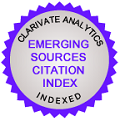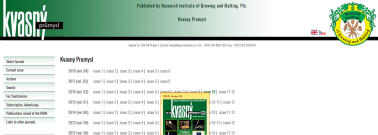
Manuscript Preparation Guidelines
We welcome high-quality original munuscripts that are beneficial for the scientific community.
Publishing in Kvasny prumysl is free of charge. Article submission charge or article processing charge is not required.
Original papers are accepted in English.
(Authors writing in Czech or Slovak are encouraged to send a Czech or Slovak version of revised manuscript or detailed article summary to Editor-in-Chief for publication in a printed version of Kvasný průmysl, which is distributed to a professional community, mostly to Czech and Slovak breweries. Authors can also contact Editor-in-Chief with proposals of another relevant, interesting content for this printed journal.)
Manuscript preparation
The upper length of manuscript is approximately 10 pages, including tables and references.
Do not use more than 3 levels of headings.
Use Sans-Serif font for text, graphs and tables.
Title should not contain abbreviations and surplus words (assessment, study, descriptions, brief results, preliminary information etc.). The maximum length of title is two lines.
Author names and affiliations: Co-authors shall identify a corresponding author.
Abstract: A factual abstract is required. It shall be clear and comprehensible, will describe objective, methods, materials, results and conclusions. No abbreviations should be used. No references are given in the abstract. The maximum length of the abstract is 250 words.
Keywords characterize the content of the contribution.
Example: Bacterial Persistence, Saccharomycetes, Cells, Tolerance, Malt, Saaz, Biofilms; System
Keywords must be submitted into metadata separately.
Introduction contains a description of the problem and a brief survey of the literature on the subject. It proceeds from general to specific information and brings replies to questions: What is the topic of the manuscript? What are the main objectives of the research?
Each specific statement is followed by the reference to literature. The introductory section should include pertinent literature citations evidencing the state of current knowledge.
Aims and hypotheses are outlined at the end of the introduction.
Material and methods give answer to the question: How was the problem studied? This part of the manuscript gives information guaranteeing the reproducibility of experiments. Materials are exactly described and defined (sampling, sources, locality, processing etc.). The literature relating to the method applied including statistical methods is given; a type and manufacturer of devices are specified.
Results and discussion provide answers to questions: What was found? What the results are testifying about? Major results from experiments and monitoring are summarized. Discussion should explain the importance or reasons of differences between the results described in the manuscript and those obtained by other authors and the new hypothesis can be postulated.
Conclusion summarizes results in a condensed form, referring to so far unsolved issues.
Acknowledgement The number of grant and grant agency providing finance support are given. Persons (organizations) who are not included within the authors and who participated in project realization or sponsors who financially supported the project solved could be acknowledged too.
Figures
PDF, PNG or JPG images should be used. All figures should be sent separately.
Captions should be given in a text file, not attached to the figure.
Tables
Use Sans-Serif font for tables and graphs.
Figures and tables must be numbered. All tables and figures should be referred to in the text. Abbreviations in tables and figures shall be explained in the table notes and figure captions.
Example: Figure 1 shows something. Our experimental results are presented (Fig. 1). Our experimental devices are also presented (Figs. 2, 3).
DOI
Where available, DOI and URLs for the references must be given.
DOIs can be found within the article full text, content, or article information at the journal (publication) or publisher website, or in the publisher on-line database.
References
List of References contains list of all references cited in the study. References should be sorted alphabetically by the first author's surname.
Do not cite unavailable literature sources (e.g. unavailable proceedings from conferences).
Where available, DOIs, URLs and ISBN for the references shall be provided.
All references mentioned in the Reference list shall be cited in the text, and vice versa.
References in the text are referred to as follows: one author – (Troi, 2016); more authors – (Picard et al., 2018).
If the author presents several references at once, they are separated from each other by a semicolon: (Troy, 2013; Crusher, 1993).
Journals should be abbreviated according to the rules used in Chemical Abstracts Source Index – http://cassi.cas.org/search.jsp see examples below:
Journal articles:
Brožová, M., Kubizniakova, P., & Matoulková, D. (2019). Brewing microbiology – bacteria of the genus Clostridium. Kvasny prumysl, 64(5), 242–247. https://doi.org/10.18832/kp201830
Books and monographs:
Basařová, G., Šavel, J, Basař, P., Lejsek, T., 2010: Pivovarství: Teorie a praxe výroby piva. VŠCHT v Praze. ISBN 978-80-7080-734-7.
Storgårds, E., Yli-Juuti, P., Salo, S., Wirtanen, G., Haikara, A., 1999: Modern methods in process hygiene control - benefits and limitations. Proceedings of the 27th Congress of European Brewery Convention, Cannes, 29 May - 3 June 1999. 249–258. ISBN 90-70143-20-8.
Standards:
ČSN ISO 690. Bibliografická citace: obsah, forma a struktura, 31. Praha: Český normalizační institut, 1996.
ISO/IEC IS 9126-1.: Software Engineering - Product Quality – Part 1: Quality Model. Geneva, Switzerland: International Organization for Standarization, 2001.
Patents:
Nová huť, a.s., Ostrava. Trysková sestava přestupníkového kolena. CZ Patentový spis 279967, Dec 29, 1990.
Sheem, S. K. Low-Cost Optic Pressure Sensor. US Patent 6,738,537, May 18, 2004.
Online sources:
NCBI [online]. http://www.ncbi.nlm.nih.gov/entrez/viewer.fcgi?db=protein&val=11072111 [vid 2008-03-31].
U.S. Environmental Protection Agency [online]. http://www.epa.gov [ 2011-10-27].






